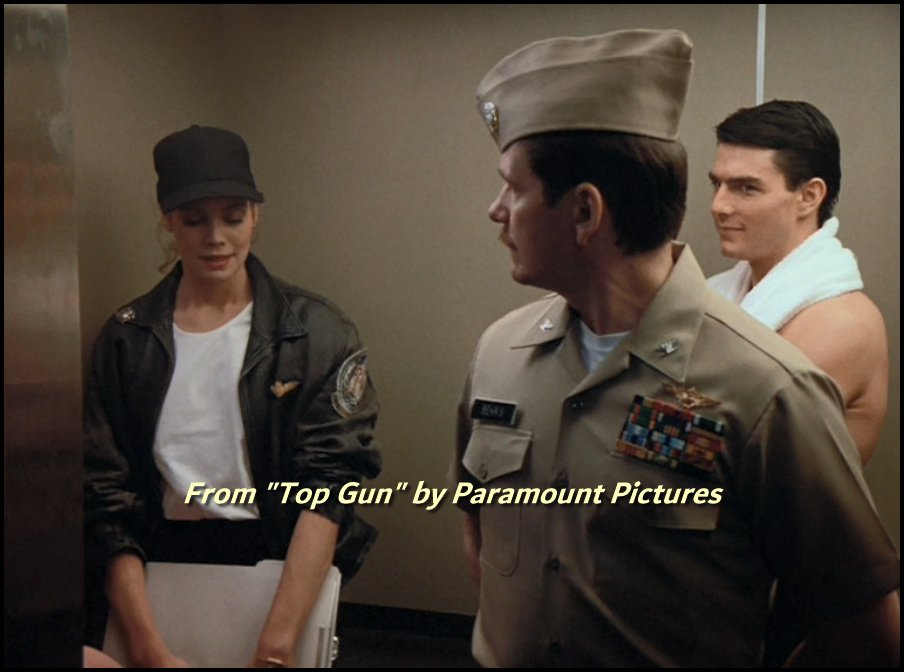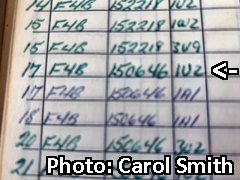Snapshot Drills
Fighters sometimes performed shapshot drills on the way to the range as a way to loosen up and get in the proper mindset before the main event -- the day's planned engagements. They were brief segments of air combat. Here you'll find brief notes and short stories from my own experience and a very few others; the origin will be clear. I don't have a schedule, will add them as I can. New stories will be at the top. Turn in!
The elevator scene in the movie "Top Gun"
There are many technical and production details from “Top Gun.” A friend recently asked me about the Navy captain in the elevator scene. It begins around the 48-minute mark on my DVD copy: Maverick and Charlie in an elevator, a Navy captain enters. Who is the captain? Was he a real Navy officer, as were some of the other extras in the movie?
I was a Topgun instructor when they filmed the movie and flew some of the flying scenes, but I did not know the answer to this one, so I turned to John Semcken. John is a former F-14 pilot and TOPGUN graduate who provided extensive and valuable assistance to Paramount for the movie. He is in the credits as “Lt. John Henry Semcken -- cooperation and support officer: U.S. Navy,” and he and I went to Paramount to help edit and create dialogue for the flying scenes.
John said, the elevator scene is “one of the scenes that was added after principle photography was complete, in other words after the filming was over. Cruise was in Chicago filming the movie Color of Money. You can tell for two reasons: 1. His hair was longer so they slicked it back and 2. In Color of Money he had an earring, that of course would not work in Topgun, so if you look at his ear he has a patch covered in makeup on his ear. You wouldn’t notice if not looking for it.”
John also pointed out what all West Coast fighter guys know: that there was no building on NAS Miramar with an elevator, and certainly not one that would take that long!
Paramount flew John to Chicago for this scene because Tom Cruise had come to trust and rely on him. The elevator scene was filmed in Chicago and the “Navy captain” was an actor. I tried to find his name but I could not find him in the credits.
With that answered, John pointed out several other interesting details. For one, he confirmed that in the later filming, after principle photography was complete, the production team added several lines that he and I gave them during our trip to Hollywood, to clarify plot points.
John also said that he was recruited to read some lines for actor Tim Robbins’ character (Merlin), and he was coached by Tom Cruise. But in the end the studio reached an agreement with Robbins and he added the additional lines.
John finished with this statement: “What I always tell people about the movie, everything you think is real (aileron roll of the cat) is not real and everything you think is not (Kelly as Christine Fox and the flat spin) is!”

Correcting the record on Page/Smith MiG-kill Phantom
On their MiG-killing mission of June 17, 1965, Commander Lou Page (pilot) and Lieutenant JC Smith (RIO) were flying F-4B bureau number (buno) 150646, not 151488 as sometimes reported. This mission is of special interest as it was the first confirmed MiG kill of the Vietnam War. Page and Smith were with VF-21, and the aircraft modex was NE101.
The buno was confirmed by (1) phone call on August 12, 2019, between JC Smith and Dave Baranek (ex-F-14 RIO and Topgun instructor) and (2) photo of Smith’s logbook from June 1965.
There is a photo of the aircraft in the book “MiG Killers of Yankee Station,” by Michael O’Connor. On that flight, the front canopy rail bore the name of VF-21’s commanding officer, Commander Bill Franke, with Lieutenant (j.g.) James Mills on the rear canopy rail.
Many sources in print and on the Internet report that Page and Smith flew 151488 for their MiG kill, but this is erroneous. The confusion could be attributed to developments in the months after the historic kill. First, 150646 was lost on July 28, 1965, just a few weeks after the MiG kill. (The loss of 150646 is detailed in the vietnamairlosses.com database: the aircraft suffered engine and electrical power failure; both crewmen ejected and were rescued.)
After 150646 was lost, VF-21 designated 152219 as NE101. Interesting note, 152219 was the jet flown by Page/Smith's wingman, Batson/Doremus, who also scored. Then, just prior to Midway's return from deployment, 151488 was designated NE101.
On August 24, 1965, Commander Franke was shot down and became a POW. Commander Page, who had been VF-21 executive officer, became the commanding officer per Navy standard procedures. When Page became CO, the names on NE101 were changed to Page and Smith, and their MiG kill was painted on the aircraft. There are photos of both 152219 and 151488 as NE 101 with a MiG kill on the intake splitter. It was there because the aircrew, Page and Smith, scored a kill. (Of additional interest, Franke’s RIO when he was shot down was Lieutenant Commander Rob Doremus, who was flying with Lieutenant Dave Batson on June 17, as Page’s wingman, and also scored. Franke and Doremus were released in 1973 after 7½ years in captivity.)
The correct buno is reported in “MiG Killers of Yankee Station” and explained in endnote #21.


The Back Story on How the Navy’s Jolly Rogers Remained an Active Squadron, by CAPT Alex "Yogi" Hnarakis, USN (Ret.)
INTRO: The Jolly Rogers have for years been one of the Navy’s high-profile fighter squadrons. Former Tomcat pilot and Jolly Rogers commanding officer, CAPT Alex “Yogi” Hnarakis, USN (Ret.), told me the following story and has given me permission to use it. Yogi’s story:
In the fall of 1995 when VF-84 was decommissioned, VF-103 adopted the Jolly Rogers name to replace their previous name, the Sluggers. That decision dated back about nine months prior to the VF-103 change of command reception, when CAPT Dale "Snort" Snodgrass, the Fighter Wing Commander, asked VF-103’s new CO, Steve "Snotty" Schlientz and me (as the incoming XO) to visit him the next workday.
Snort laid out that the VF-84 Jolly Rogers and VF-14 Tophatters were both on the chopping block as the Navy moved from two Tomcat squadrons per airwing to one. He had "shopped" the existing Tomcat monikers, Jolly Rogers and Tophatters logos to the expanding Hornet community. But Snort had no luck even with newer Hornet squadrons that had no lengthy history. Since the Tophatters were the oldest continuously active squadron in the Navy and the Jolly Rogers dated back to at least WWII as part of several different squadrons, Snort wanted those long standing monikers preserved.
When Snort had to field a phone call while we were in his office, Snotty and I huddled and agreed that Snort wasn't really asking, he was informing us in a way that sounded like asking. When Snort finished his call, Snotty told him that we needed to socialize it with our squadron but that if required, we would rather switch to the "Bones” (assume the Jolly Rogers identity). Snort said the decommissionings were still months away, not completely final, but that the Tophatters would have priority due to their “oldest” status.
Snotty and I organized truly anonymous polling within the squadron without any “sales pitches” about whether or not to change from the Sluggers, but if so, to which one: Jolly Rogers or Tophatters. It turns out there was overwhelming support at all levels within the squadron to convert VF-103 to the Jolly Rogers from the Sluggers.
Several months later, the Tophatters came off the decommissioning list. They would continue as VFA-14 flying SuperHornets. In VF-103, we worked with VF-84 to make the moniker/logo transition a smooth one at their decommissioning in October 1995, and also worked with FighterWing to secure official approval at the highest levels of the Navy. For example, we needed to comply with Naval History rules that said each squadron had only one ‘official history’ and VF-103's official history was the Sluggers until switch to Jolly Rogers. Any mention of the Jolly Rogers that pre-dated VF-103's official conversion was to be completely unofficial. For less-formal VF-103 squadron histories, such as those printed for change of command brochures, we envisioned a mix of the official history as VF-103 Sluggers and those accomplishments, and then carried forward officially as the VF-103 Jolly Rogers from fall 1995. But we also envisioned doing a quick "rewind" to unofficially acknowledge all the previous units that had used the Jolly Rogers moniker. That way we were trying to maintain unofficial awareness of both Sluggers and Jolly Rogers past accomplishments no matter which squadrons had previously used them.
Snotty, as our CO, fielded some phone calls before the switch from some former VF-103 Sluggers expressing displeasure that we were going to switch to the Jolly Rogers. He was diplomatic and explained our path forward to attempt to unofficially preserve awareness of the Sluggers and Jolly Rogers. Naval Aviation, like all military forces, has colorful histories that are worth preserving, even if it sometimes requires passing the banner to a new team.
(end)
